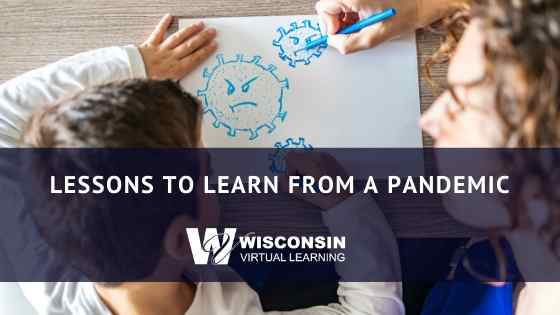Those of us who school from home may be feeling relieved to not have had to “upturn the applecart” when traditional schools closed due to the pandemic. Nothing, as far as schooling is concerned, has really changed for Wisconsin Virtual Learning students. What may have changed, however, is how our kids feel now that the usual routines of life have been uprooted. Maybe a parent is out of work, a sports team disbanded, the neighborhood camaraderie gone. The simple act of not being able to be in public can be emotionally destabilizing for children. It can also be frightening.
Like all things that scare us, education is the key to understanding the problem and taking away the “fear-factor” that can run rampant when we allow our imaginations to replace factual information. And while we can’t see pandemics as a positive, there are ways to educate your WVL student to help them adapt and overcome the current situation and come out more resilient on the other side.
It’s important to remember when educating a child on something like the pandemic, to keep it age-appropriate. Death statistics are probably not going to be understood by younger kids and would serve to scare rather than educate. You know your child’s capacities best and have to use your own best judgment to determine what information is appropriate for your kids.
Inside every pandemic, from the beginning of civilization, there have been important lessons learned. Older children may be able to draw some parallels between pandemics in ancient history and the current Coronavirus pandemic. They can pull key data that serves to reassure them like:
- All pandemics have come to an end – this too will not last forever.
- Healthcare and sanitation have improved since the first pandemics in recorded history increasing the probability that they and their family will be “alright” if they did become sick.
- Humans can control outbreaks by their behavior
Lessons like these can empower frightened youngsters and help them better understand that, while there is no definitive answer to when the current restrictions will end; they will end, they aren’t a punishment, and we’ve been here before. For those who have greater interest in science, math, computers, or health care, there are many other options to enhance learning using data and statistics provided by the CDC and NIH.
Younger children may want to learn simpler things, like the differences between viruses, bacteria, and parasites. They may want to learn practical things like how to take a temperature or wash hands appropriately.
The best guidance we can give is to let your children guide you. Some children will feel better by acquiring more knowledge about their current situation – others won’t. Encourage, don’t push, them to express themselves through art, music, or writing. Remind them that there are other ways to stay in touch other than face to face. Reassure them that this will end and you are doing everything you can do to keep them safe. Empower them to ask questions and take action to help themselves get through this pandemic better, stronger, and more resilient on the other side.

